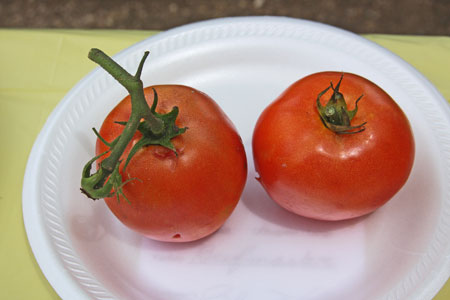|
Tomato Preparation Guide for Showing and Displaying
Drs. Roland Roberts, Tom Longbrake, Sam Cotner and
John Larson, Retired Extension Vegetable Specialists, The Texas A&M University System
Quality Specifications for Vegetables
Many carefully cultured vegetables fail to win top honors because of improper handling and trimming in preparation for the show. Exhibitors can assure themselves a far better chance of receiving high awards for their entries by carefully reading and following the size and quality requirements for each kind of vegetable they intend to enter in the show.
The different kinds or species of vegetables are denoted by names such as carrot, cabbage or tomato. Within each kind of vegetable there are many distinct varieties. For example, several tomato varieties are Tycoon, BHN 968 and Tygress. These tomato varieties differ in fruit size, shape, flavor, plant type, days-to-maturity, disease resistance and climatic requirement. Therefore, it is very important for the exhibitor, the judges and the people who come to see the show know the different kinds and varieties of vegetables on display. The kind and variety of vegetable should be written on each entry card.
Certain characteristics are common to all blue ribbon winners. The entry must be what it claims to be; that is, it must be “true to type.” All specimens in an entry must be uniform in size, shape, color and maturity. All specimens must be trimmed alike. Champion vegetables are always at prime eating quality –never too old or too young, never too tough or too soft, never scratched or bruised. Freedom from insect and disease damage is important, as is freedom from drought and nutrient deficiency injury.
Show vegetables must be scrupulously clean without having a scrubbed appearance. Leafy vegetables (lettuce, cabbage and spinach) should be briefly soaked and gently sprayed with water, then stored in a cool, damp place for the short period until show time. Fruiting vegetables (tomatoes, cucumbers, peppers and beans) should be rubbed lightly with a soft cloth as they are rinsed under a gentle stream of water, then carefully dried and stored in a dry, cool place until show time. Root crops should be soaked for several minutes immediately after harvest, and then rubbed gently with a soft cloth under running water to remove soil. Never scrub or brush vegetables intended for a show.
Suggested Specifications for Tomatoes
Tomato, Cherry
6 fruits — Stems (calyx) may be left on, but must be green and fresh. Uniformity is size, color, shape, and maturity is important. Fruits must be free of cracks and damage.
Tomato, Pear
6 fruits — Pear tomatoes of Italian tomatoes are prepared and shown in a manner similar to cherry tomatoes.
Tomato, Large, Red
3 marketable fruits — Fruits may be either green or red. All fruits must be uniform in every way. Firm, crack-free, smooth fruits are desirable. If calyx is left intact, it must be fresh and green. The green calyx adds to the fruit’s appearance only if it is fresh.

A very uniform cluster sample - stems attached and fruit is the same ripeness except those at the end of the cluster which is normal.
|

A very uniform fruit sample but stems not evenly trimmed and some stems dried and missing.
|

A very uniform sample but some stems are missing. The fruit are the same size and ripeness.
|

A very uniform sample but stems are unevenly trimmed. The fruit have some discoloration and damage.
|

A very uniform sample except for one small fruit on top right – some stems are missing or disconnected.
|

A very uniform sample - stems evenly trimmed, fruit the same ripeness and size. THIS SHOULD HAVE BEEN A WINNER!
|

Dead stem on one fruit and stems cut at different lengths.
|

Not a uniform sample - fruit is not the same ripeness and with discolorations.
|

Not a uniform sample - stems unevenly trimmed, fruit ripeness and size different.
|

Not the same fruit ripeness and stems unevenly trimmed.
|

This sample is disqualified because it has only two fruit rather than the required three fruit.
|
|

|
|
|



